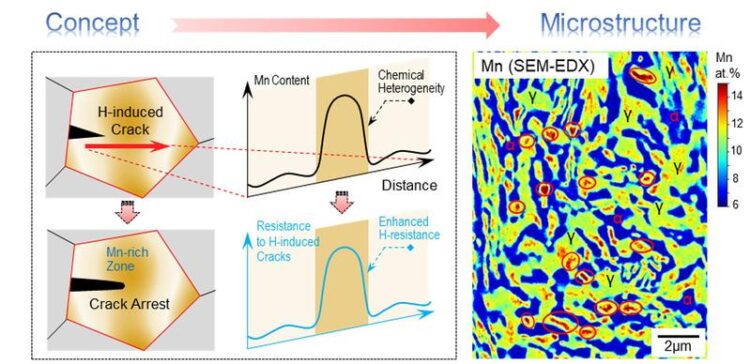Dead ends for hydrogen-induced cracks in steels

The exploration of chemical heterogeneity inside the microstructure leads to an enhanced resistance to hydrogen induced cracking, thus suppressing hydrogen induced premature failure .
The figure was reproduced from B. Sun et al, Nat. Mater. 2021
Max Planck scientists publish their latest findings in the journal Nature Materials.
Hydrogen – the smallest of all atoms and yet becoming more and more important in terms of climate neutrality. While politics, industry and research are heading to use as much hydrogen as possible as a sustainable energy carrier, hydrogen embrittlement of high-strength alloys has become one of the major issues impeding the realization of the hydrogen economy. These materials are urgently needed for the automotive and aerospace industry to construct lightweight structural components, and in all other components used for storing and transporting hydrogen. Scientists of the Max-Planck-Institut für Eisenforschung (MPIE) and their colleagues from the Tsinghua University China and the Norwegian University of Science and Technology, found a way to stop hydrogen-induced cracks in high-strength steels. The researchers published their latest findings in the journal Nature Materials.
“Steels represent 90% of the global metallic alloy market and are at the same time particularly prone to hydrogen embrittlement. That’s why our aim was to find an inexpensive, scalable strategy to make steels more resistant to hydrogen while keeping their mechanical performance.”, explains Dr. Binhan Sun, postdoctoral researcher, topic leader of Hydrogen Embrittlement in High-Performance Alloys at the MPIE and first author of the publication. The scientists implemented manganese-rich domains in the steel’s microstructure to blunt cracks and trap hydrogen inside and thus stop crack propagation.
“We tested our approach with lightweight high-strength manganese steels where we produced an extremely high number density (above ~2 × 1018 m–3) of manganese-rich buffer zones. These buffer zones represent dead ends for cracks by blunting sharp cracks. This makes the steel twice as resistant to hydrogen as conventional chemically homogeneous steels, regardless of when and how hydrogen enters the material.”, states Dr. Dirk Ponge, head of the MPIE group “Mechanism-based Alloy Design” who supervises the study.
The presented method can, in principle, be applied to over 10 established steel grades. The scientists also see possible applications for other alloys (such as multiphase titanium alloys), which need to be strong, ductile and hydrogen-resistant. However, before widening the range of alloys, the researchers are now aiming to find different methods to accurately produce domains of chemical heterogeneity inside the microstructure. These different methods could further enhance the crack-resistance effect and better fit established industrial processing routes.
Wissenschaftliche Ansprechpartner:
Dr. Binhan Sun, b.sun@mpie.de
Dr. Dirk Ponge, ponge@mpie.de
Originalpublikation:
B. Sun, W. Lu, B. Gault, R. Ding, S. K. Makineni, D. Wan, C.-H. Wu, H. Chen. D. Ponge, D. Raabe: Chemical heterogeneity enhances hydrogen resistance in high-strength steels. In: Nature Materials 2021, https://doi.org/10.1038/s41563-021-01050-y
Weitere Informationen:
https://www.mpie.de/4580549/dead-ends-for-hydrogen-induced-cracks
Media Contact
All latest news from the category: Materials Sciences
Materials management deals with the research, development, manufacturing and processing of raw and industrial materials. Key aspects here are biological and medical issues, which play an increasingly important role in this field.
innovations-report offers in-depth articles related to the development and application of materials and the structure and properties of new materials.
Newest articles

First-of-its-kind study uses remote sensing to monitor plastic debris in rivers and lakes
Remote sensing creates a cost-effective solution to monitoring plastic pollution. A first-of-its-kind study from researchers at the University of Minnesota Twin Cities shows how remote sensing can help monitor and…

Laser-based artificial neuron mimics nerve cell functions at lightning speed
With a processing speed a billion times faster than nature, chip-based laser neuron could help advance AI tasks such as pattern recognition and sequence prediction. Researchers have developed a laser-based…

Optimising the processing of plastic waste
Just one look in the yellow bin reveals a colourful jumble of different types of plastic. However, the purer and more uniform plastic waste is, the easier it is to…



